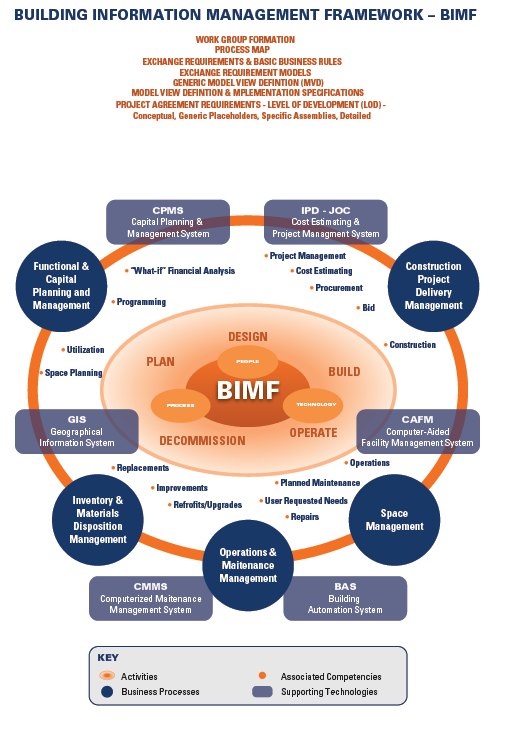While at first perhaps a bit intimidating… illustrating the life-cycle management within a BIM context is relatively straightforward.
BIM – Life-cycle Management Perspective
The purpose of this Framework is to provide a general guide that your team can quickly customize to your specific requirements. Like a restaurant menu or a travel guide, you can visualize the resources available and decide on an appropriate strategic configuration of options.
Just begin in the Center and work thru this Action Agenda using, when available and appropriate, tested processes and templates. Using these guidelines, set up a BIM Management structure with your stakeholders.
The Building Information Management Framework (BIMF) illustrates a how people, processes, and technology interact to support the built environment throughout its life-cycle. Based upon the associated level of detail, an operating model can be developed to more efficiently identify, prioritize, and meet the current and future needs of built environment stakeholders (Owners, AE’s, Contractors, Occupants, Oversight Groups…)
More specifically, modular, Model View Definitions (MVD), associated exchange specifications and common data architectures [for example: Industry Foundation Class (IFC), OMNICLASS] can help to integrate multi-discipline Architecture, Engineering, Construction (AEC) “activities”, “business processes”, “associated competencies” and “supporting technologies” to meet overall requirements with a goal of continuous improvement.
WORK GROUP FORMATION – Roles and Relationships;
PROCESS MAP – who does what, in which sequence, and why;
EXCHANGE REQUIREMENTS & BASIC BUSINESS RULES – Overall guidelines for information integration
EXCHANGE REQUIREMENT MODELS – Specific information “maps”
GENERIC MODEL VIEW DEFINTION (MVD) – Strategic approach incorporating guidelines for information format, content, and use;
MODEL VIEW DEFINTION & IMPLEMENTATION SPECIFICATIONS – Specific format, content, and use
PROJECT AGREEMENT REQUIREMENTS – LEVEL OF DEVELOPMENT (LOD) – Defined “project” deliverables
(Adapted from: IMPROVING THE ROBUSTNESS OF MODEL EXCHANGES USING PRODUCT MODELING ‘CONCEPTS’ FOR IFC SCHEMA –Manu Venugopal, Charles Eastman, Rafael Sacks, and Jochen Teizer – with ongoing assistance/input from NBIMS3.0 Terminology Subcommittee)
Model View Definitions (MVD) and associated exchange specifications, provide the best benefit if they are modular and reusable and developed from Industry Foundation Class (IFC) Product Modeling Concepts. Model views and overall life-cycle management are similar in this regard.
Building Information Modeling (BIM) tools serving the Architecture, Engineering, Construction (AEC) span multiple “activities”, “business processes”, “associated competencies” and “supporting technologies”, and each may required different internal data model representation to suit each domain. Data exchange is therefore a critical aspect. Inter and intra domain standardized data architectures and associated adoption of matching robust processes are really the first step toward successfully managing the built environment.
- The Process Side of BIM = Collaboration: People, Process, & Technology


